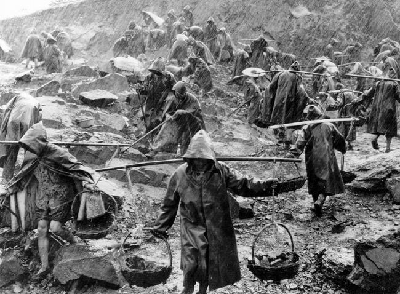| |
In August 1951, the 3rd World Youth Festive was held in Berlin, East Germany. A Chinese photo show was sponsored on the occasion, which was the first time to display photographic works of New China in the international arena. The photo show exhibited the image of New China and its process of growth through vivid and true photos, attracting great interests of the international photographic circles. In 1958, Chen Bo, deputy secretary general of PSC, visited Hungary, which was the first time that a Chinese photographer visited a foreign country after the founding of New China. During the period, Chen Bo visited the second session of the International Photographic Exhibition, sponsored by Hungary, and inspected the situation of Hungarian photography. In 1961, Shi Shaohua, PSC chairman, was invited to attend the Moscow International Photographic Exhibition in the Soviet Union, and acted as a member of the panel of judges. According to the cultural exchange agreement between the Chinese and Mongolian governments, Wu Qun, PSC secretary general, visited Mongolia for photographic exchanges. In 1963, Shi Shaohua and Chen Bo, in the name of the Chinese photography delegation, visited Vietnam, and participated in the opening ceremony of the Chinese Photographic Works Show in Hanoi. Vietnamese Chairman Ho Chi Minh warmly met with the delegation. In the same year, Lu Houmin, a Chinese photographer, went to attend the opening ceremony of the Film Show of World People against Imperialists in Cuba, and visited Cuba. During the period, China also sent a dozen of photographer delegations to visit the Soviet Union, Vietnam, Romania, Cuba, Democratic People's Republic of Korea, Albania, and Poland, enhancing mutual understanding and friendship with the photographic circles in these countries. In the course of communicating with socialist countries, the Chinese photographic circle also conducted friendly and professional exchanges with other countries. In early 1965, Wu Yinxian, vice-chairman of PSC, headed a Chinese photographer delegation to Japan. It came into contact with famous Japanese photographers Ihei Kimura and Watanabe Yoshio, and strengthened ties between the Chinese and Japanese photographic circles.
Many famous foreign photographers came to visit China in succession. In 1958, Henri Cartier-Bresson, a famous French photographer, visited China. Bresson started to take photographs in 1931, and visited many countries. He was known for rapidly catching the most representative moment in artistic creation. He advocated that photographers should not interfere, stage or process the targets of photography. For this, he was looked upon as a representative of the documentary photography. During his visit of China, Bresson took a lot of photographs throughout the country. In 1963, a Japanese photography delegation, headed by Ihei Kimura, a famous Japanese photographer and advisor of Japan Photo Association, visited China. Ihei Kimura, a veteran in the Japanese photographic circle, started his photographic career in 1933. His works were known for their strong senses of reality and life. He set up many photographic organizations with friends, and contributed significantly towards the progress of the Japanese art photography undertakings. In 1965, Ihei Kimura visited China again with a delegation.
 Chen Bo's work: Fight against Rain
Chen Bo's work: Fight against Rain
In terms of sponsoring photograph shows, PSC held Chinese photographic exhibitions in the capitals of 19 countries from 1958 to 1964, which were the Soviet Union, Poland, Czechoslovakia, Japan, Tunis, Mali, Chile, Australia, New Zealand, Cuba, the Netherlands, Bolivia, Zanzibar, Indonesia, Burma, Ceylon(Sri Lanka), Laos, Vietnam, Guyana. These photographic shows exhibited a wide range of subjects in New China, such as industrial and agricultural construction, social environments, people’s lives, portraits, landscapes, and objects. They were welcomed by foreign audiences. In 1959, PSC was honored a group award for its exhibition in Poland. Liu Entai was awarded for his photograph Extension of Jilin Thermal Power Plant, Li Shuliang for his work Threshing, Chen Bo for his work Fight against Rain. In 1959, to celebrate the 10th anniversary of the founding of the People’s Republic of China and introduce the Chinese socialist construction achievements and people’s lives to foreign audiences, PSC selected some photographs and exhibited them in about 20 countries, which were the Soviet Union, Poland, Mongolia, Czechoslovakia, Bulgaria, Hungary, Romania, Sweden, Ceylon, Afghanistan, Sudan, Belgium, Burma, Iraq, India, Indonesia, Denmark, Iceland, Britain, Nepal, Yemen, Switzerland, Vietnam, Albania, Democratic Germany, and DPRK.
Photographic works exhibited in China during the period were represented by the following. In 1957, Watanabe Yoshio, a famous Japanese photographer, habited his individual show, Scenes of Asia, in Beijing. The 145 works were on architectures, landscapes and folk customs he shot when traveling in Asian countries. The photo show was permeated with a sense of simplicity and friendly feeling. In 1958, a Soviet Union Photographic Exhibition, totaling 166 works, was shown in Beijing and Shanghai. They included latest works of famous modern Soviet Union photographers that cover wide subjects and precise compositions. About 30,000 Chinese audiences watched the photo show. Other photo shows included the Photographic Exhibition of Czechoslovakia (1957), the Photographic Exhibition of Poland (1960), Photographic Exhibition of Soviet Union and Belorussia (1961), Photographic Exhibition of Cuba (1963), Photographic Exhibition of Romania, and Photographic Exhibition of Vietnam (1965). Besides, a photographic exhibition of photographers from Guangzhou, Hong Kong and Macao was held in Beijing in 1957. The 244 works, largely from Hong Kong and Macao, presented rich contents in diversified forms, including various photographic styles and schools. The darkroom processing was also exquisite. The photo show widened the vision of mainland Chinese photographers and fans, and contributed to expanding the fields of artistic creation.
|
|
